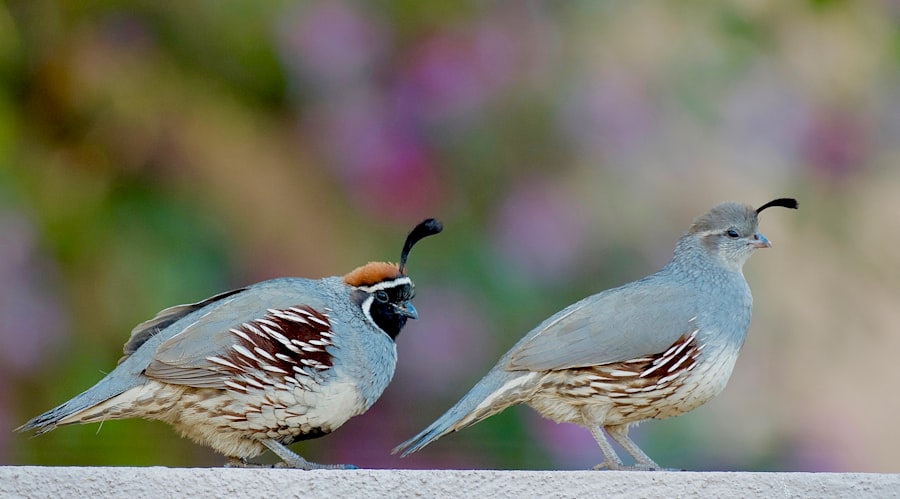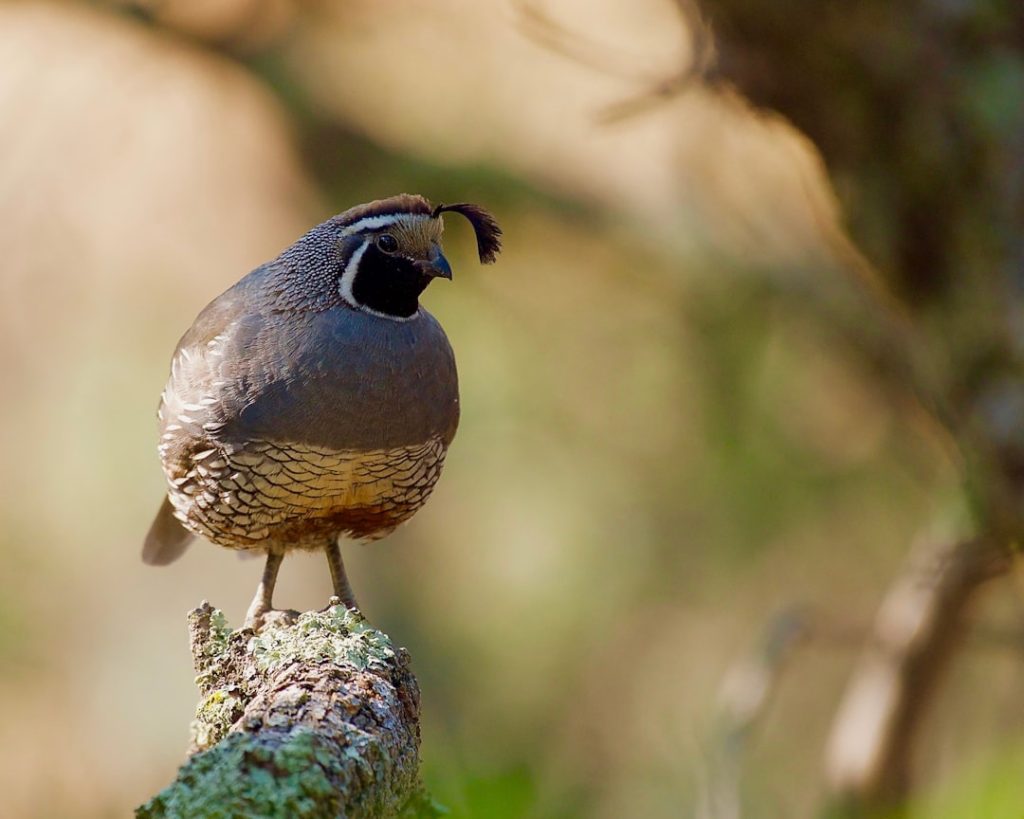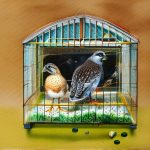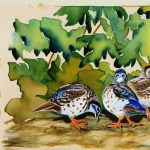The common quail, also known as the European quail, is a small game bird that is native to Europe, Asia, and Africa. It is a migratory bird that travels long distances during its annual migration. The common quail is known for its distinctive call, which is often described as a “wet-my-lips” sound. These birds are ground-dwelling and prefer open grasslands and agricultural fields as their natural habitat. They are known for their secretive nature and are often difficult to spot in the wild.
Common quails are popular among breeders and farmers for their delicious meat and eggs. They are also relatively easy to care for and can adapt well to a variety of climates. These birds are known for their high reproductive rate, with females laying up to 12 eggs at a time. Common quails are also known for their rapid growth, reaching maturity in just 6-8 weeks. They are social birds and thrive in small flocks, making them an ideal choice for small-scale breeding operations.
The common quail is a hardy bird that can adapt to a variety of environments. They are known for their ability to thrive in both hot and cold climates, making them an ideal choice for breeders in different regions. These birds are also relatively low-maintenance, requiring minimal care and attention. However, they do require proper housing, nutrition, and care to ensure their health and well-being. Understanding the natural behavior and needs of the common quail is essential for successful breeding and raising of these birds.
Table of Contents
- 1 Selecting Breeding Stock
- 2 Housing and Equipment
- 3 Nutrition and Feeding
- 4 Breeding and Incubation
- 5 Caring for Chicks
- 6 Common Quail Breeding Challenges and Solutions
- 7 FAQs
- 7.1 What is common quail breeding?
- 7.2 What are the benefits of common quail breeding?
- 7.3 What are the basic requirements for common quail breeding?
- 7.4 What are some common challenges in common quail breeding?
- 7.5 What is the breeding season for common quails?
- 7.6 How long does it take for common quails to reach breeding age?
Key Takeaways
- Common quail are small, ground-dwelling birds known for their distinctive call and are popular for their meat and eggs.
- When selecting breeding stock, look for healthy, active birds with good body conformation and no signs of disease.
- Provide housing with proper ventilation, lighting, and temperature control, and equip with suitable nesting materials and feeders.
- Ensure a balanced diet for quail with a mix of commercial feed, greens, and grit to support their growth and reproduction.
- Monitor breeding and incubation closely, providing a suitable environment and handling eggs carefully to maximize hatch rates.
Selecting Breeding Stock
Selecting the right breeding stock is crucial for successful quail breeding. When choosing breeding stock, it is important to select birds that are healthy, active, and free from any genetic defects or diseases. Look for birds that are alert, have bright eyes, and a glossy coat. Avoid birds that appear lethargic or have any signs of illness. It is also important to select birds that have good body conformation and are of the appropriate size and weight for their breed.
When selecting breeding stock, it is important to consider the genetic diversity of the birds. Inbreeding can lead to genetic defects and health issues in the offspring. It is important to choose breeding stock from different bloodlines to ensure genetic diversity and reduce the risk of genetic abnormalities. It is also important to consider the temperament of the birds when selecting breeding stock. Look for birds that are calm and docile, as aggressive or skittish birds may be difficult to handle and may not be suitable for breeding.
It is also important to consider the age of the breeding stock when selecting quails for breeding. Younger birds are generally more fertile and have a higher reproductive rate than older birds. However, it is important to avoid breeding birds that are too young, as this can lead to health issues and reduced fertility. It is generally recommended to start breeding quails when they are around 6-8 weeks old. By carefully selecting breeding stock based on health, genetics, temperament, and age, breeders can ensure the success of their quail breeding operation.
Housing and Equipment
Proper housing and equipment are essential for successful quail breeding. When setting up housing for quails, it is important to provide a clean, dry, and well-ventilated environment. Quails are ground-dwelling birds and require adequate space to move around and exercise. A good rule of thumb is to provide at least 1 square foot of space per bird in the housing area. The housing should also be predator-proof, with secure fencing or wire mesh to prevent predators from entering the enclosure.
Quails also require nesting boxes or shelters where they can lay their eggs and seek refuge. Nesting boxes should be filled with clean bedding material such as straw or wood shavings to provide a comfortable and safe environment for the birds to lay their eggs. It is important to regularly clean and replace the bedding material to prevent the buildup of bacteria and parasites.
In addition to housing, it is important to provide the necessary equipment for feeding and watering the quails. Quails require access to clean water at all times, so it is important to provide waterers that are easy to access and refill. It is also important to provide high-quality feed that is specifically formulated for quails. Quails have specific nutritional requirements, so it is important to provide a balanced diet that includes protein, vitamins, and minerals.
It is also important to provide adequate lighting in the quail housing area. Proper lighting can help regulate the birds’ reproductive cycles and encourage egg production. It is generally recommended to provide 14-16 hours of light per day for quails to stimulate egg laying. By providing proper housing and equipment, breeders can create a comfortable and healthy environment for their quails to thrive.
Nutrition and Feeding
Proper nutrition is essential for the health and well-being of quails. Quails have specific nutritional requirements that must be met to ensure their growth, reproduction, and overall health. A balanced diet for quails should include high-quality feed that is specifically formulated for game birds. Quails require a diet that is high in protein, with at least 24-28% protein content in their feed. Protein is essential for muscle development, egg production, and overall growth in quails.
In addition to protein, quails also require a diet that is rich in vitamins and minerals. It is important to provide a feed that includes essential vitamins such as vitamin A, vitamin D, and vitamin E, as well as minerals such as calcium and phosphorus. These nutrients are essential for bone development, eggshell formation, and overall health in quails.
It is also important to provide access to clean water at all times for quails. Water is essential for digestion, temperature regulation, and overall health in quails. It is important to regularly clean and refill waterers to ensure that the water remains clean and free from contaminants.
In addition to providing a balanced diet, it is important to monitor the feeding habits of quails to ensure that they are eating enough food. Quails should have access to feed at all times, but it is important to monitor their food intake to prevent overeating or underfeeding. By providing a balanced diet and monitoring the feeding habits of quails, breeders can ensure the health and productivity of their birds.
Breeding and Incubation
Breeding and incubation are crucial stages in the quail breeding process. Quails reach sexual maturity at around 6-8 weeks of age, at which point they can start laying eggs. It is important to provide a comfortable nesting area with clean bedding material where the female quails can lay their eggs. Quails typically lay one egg per day, with a clutch size of up to 12 eggs.
Once the eggs have been laid, they can be collected and placed in an incubator for hatching. It is important to handle the eggs carefully to prevent any damage to the delicate shells. The incubation period for quail eggs is approximately 17-18 days. It is important to maintain proper temperature and humidity levels in the incubator to ensure successful hatching.
During the incubation period, it is important to regularly monitor the eggs for signs of development and remove any eggs that appear infertile or damaged. It is also important to turn the eggs several times a day to ensure even heat distribution and proper development of the embryos.
Once the eggs have hatched, it is important to provide a warm and safe environment for the chicks to grow and develop. Chicks should be provided with access to clean water and high-quality chick starter feed that is specifically formulated for young quails. By carefully managing the breeding and incubation process, breeders can ensure a high hatch rate and healthy chicks.
Caring for Chicks

Caring for quail chicks requires careful attention and proper management. Chicks should be provided with a warm environment with access to clean water and high-quality chick starter feed. It is important to monitor the chicks closely for signs of illness or distress and provide any necessary medical care.
Chicks should be kept in a brooder with a heat source such as a heat lamp or heating pad to maintain a temperature of around 95-100 degrees Fahrenheit during the first week of life. The temperature can then be gradually reduced by 5 degrees each week until the chicks are fully feathered.
It is also important to provide proper bedding material such as pine shavings or paper towels in the brooder to keep the chicks clean and comfortable. Regularly clean the brooder to prevent the buildup of bacteria and parasites.
In addition to providing proper nutrition and housing, it is important to handle the chicks gently and avoid causing them unnecessary stress or injury. By providing proper care and attention, breeders can ensure the health and well-being of their quail chicks.
Common Quail Breeding Challenges and Solutions
Breeding quails can come with its own set of challenges that breeders may encounter during the process. One common challenge is maintaining proper temperature and humidity levels during incubation. Fluctuations in temperature or humidity can lead to poor hatch rates or developmental issues in the embryos. To address this challenge, it is important to invest in a high-quality incubator with precise temperature and humidity controls.
Another common challenge in quail breeding is preventing aggression among birds in the flock. Aggressive behavior can lead to injuries or stress among the birds, which can impact their health and productivity. To address this challenge, it is important to provide adequate space in the housing area and monitor the behavior of the birds closely. Separating aggressive birds from the flock may be necessary if they continue to exhibit aggressive behavior.
Disease outbreaks can also pose a significant challenge in quail breeding operations. Common diseases such as coccidiosis or respiratory infections can spread quickly among quail flocks if proper precautions are not taken. To prevent disease outbreaks, it is important to practice good biosecurity measures such as regular cleaning of housing areas, quarantine new birds before introducing them into the flock, and providing access to clean water and high-quality feed.
In conclusion, successful quail breeding requires careful attention to detail and proper management of housing, nutrition, breeding, incubation, and chick care. By understanding the natural behavior of common quails and providing them with a comfortable environment with access to proper nutrition and care, breeders can ensure the health and productivity of their birds. Despite the challenges that may arise during the breeding process, with proper planning and management, breeders can overcome these challenges and achieve success in their quail breeding operations.
If you’re interested in common quail breeding, you might also want to explore the topic of coop requirements for poultry. Understanding the needs of different poultry species is essential for successful breeding and raising. For instance, learning about the coop needs for turkeys can provide valuable insights into creating suitable living environments for your quail. Check out this informative article on “Do Turkeys Need a Coop?” to gain a deeper understanding of coop requirements for poultry and how it relates to common quail breeding.
FAQs
What is common quail breeding?
Common quail breeding refers to the process of raising and breeding common quails for their meat and eggs. This involves creating suitable living conditions, providing proper nutrition, and managing the breeding process to ensure healthy and productive quails.
What are the benefits of common quail breeding?
Common quail breeding can provide a sustainable source of meat and eggs for consumption. Quail meat is known for its high protein content and low fat, making it a healthy alternative to other meats. Additionally, quail eggs are considered a delicacy and are in high demand in certain markets.
What are the basic requirements for common quail breeding?
Basic requirements for common quail breeding include suitable housing or cages, proper nutrition including a balanced diet of seeds and grains, access to clean water, and appropriate breeding management to ensure the health and productivity of the quails.
What are some common challenges in common quail breeding?
Common challenges in common quail breeding include maintaining proper temperature and humidity levels, preventing diseases and parasites, managing breeding ratios, and ensuring the overall health and well-being of the quails.
What is the breeding season for common quails?
Common quails typically breed during the spring and summer months. It is important to provide the appropriate conditions and management during this time to encourage successful breeding and egg production.
How long does it take for common quails to reach breeding age?
Common quails typically reach breeding age at around 6-8 weeks old. It is important to separate males and females at the appropriate age to prevent early breeding and ensure the health and development of the quails.
Meet Walter, the feathered-friend fanatic of Florida! Nestled in the sunshine state, Walter struts through life with his feathered companions, clucking his way to happiness. With a coop that’s fancier than a five-star hotel, he’s the Don Juan of the chicken world. When he’s not teaching his hens to do the cha-cha, you’ll find him in a heated debate with his prized rooster, Sir Clucks-a-Lot. Walter’s poultry passion is no yolk; he’s the sunny-side-up guy you never knew you needed in your flock of friends!







